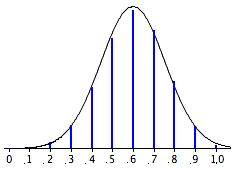9.8: Distribución de muestreo de p
- Page ID
- 152459
\( \newcommand{\vecs}[1]{\overset { \scriptstyle \rightharpoonup} {\mathbf{#1}} } \)
\( \newcommand{\vecd}[1]{\overset{-\!-\!\rightharpoonup}{\vphantom{a}\smash {#1}}} \)
\( \newcommand{\id}{\mathrm{id}}\) \( \newcommand{\Span}{\mathrm{span}}\)
( \newcommand{\kernel}{\mathrm{null}\,}\) \( \newcommand{\range}{\mathrm{range}\,}\)
\( \newcommand{\RealPart}{\mathrm{Re}}\) \( \newcommand{\ImaginaryPart}{\mathrm{Im}}\)
\( \newcommand{\Argument}{\mathrm{Arg}}\) \( \newcommand{\norm}[1]{\| #1 \|}\)
\( \newcommand{\inner}[2]{\langle #1, #2 \rangle}\)
\( \newcommand{\Span}{\mathrm{span}}\)
\( \newcommand{\id}{\mathrm{id}}\)
\( \newcommand{\Span}{\mathrm{span}}\)
\( \newcommand{\kernel}{\mathrm{null}\,}\)
\( \newcommand{\range}{\mathrm{range}\,}\)
\( \newcommand{\RealPart}{\mathrm{Re}}\)
\( \newcommand{\ImaginaryPart}{\mathrm{Im}}\)
\( \newcommand{\Argument}{\mathrm{Arg}}\)
\( \newcommand{\norm}[1]{\| #1 \|}\)
\( \newcommand{\inner}[2]{\langle #1, #2 \rangle}\)
\( \newcommand{\Span}{\mathrm{span}}\) \( \newcommand{\AA}{\unicode[.8,0]{x212B}}\)
\( \newcommand{\vectorA}[1]{\vec{#1}} % arrow\)
\( \newcommand{\vectorAt}[1]{\vec{\text{#1}}} % arrow\)
\( \newcommand{\vectorB}[1]{\overset { \scriptstyle \rightharpoonup} {\mathbf{#1}} } \)
\( \newcommand{\vectorC}[1]{\textbf{#1}} \)
\( \newcommand{\vectorD}[1]{\overrightarrow{#1}} \)
\( \newcommand{\vectorDt}[1]{\overrightarrow{\text{#1}}} \)
\( \newcommand{\vectE}[1]{\overset{-\!-\!\rightharpoonup}{\vphantom{a}\smash{\mathbf {#1}}}} \)
\( \newcommand{\vecs}[1]{\overset { \scriptstyle \rightharpoonup} {\mathbf{#1}} } \)
\( \newcommand{\vecd}[1]{\overset{-\!-\!\rightharpoonup}{\vphantom{a}\smash {#1}}} \)
\(\newcommand{\avec}{\mathbf a}\) \(\newcommand{\bvec}{\mathbf b}\) \(\newcommand{\cvec}{\mathbf c}\) \(\newcommand{\dvec}{\mathbf d}\) \(\newcommand{\dtil}{\widetilde{\mathbf d}}\) \(\newcommand{\evec}{\mathbf e}\) \(\newcommand{\fvec}{\mathbf f}\) \(\newcommand{\nvec}{\mathbf n}\) \(\newcommand{\pvec}{\mathbf p}\) \(\newcommand{\qvec}{\mathbf q}\) \(\newcommand{\svec}{\mathbf s}\) \(\newcommand{\tvec}{\mathbf t}\) \(\newcommand{\uvec}{\mathbf u}\) \(\newcommand{\vvec}{\mathbf v}\) \(\newcommand{\wvec}{\mathbf w}\) \(\newcommand{\xvec}{\mathbf x}\) \(\newcommand{\yvec}{\mathbf y}\) \(\newcommand{\zvec}{\mathbf z}\) \(\newcommand{\rvec}{\mathbf r}\) \(\newcommand{\mvec}{\mathbf m}\) \(\newcommand{\zerovec}{\mathbf 0}\) \(\newcommand{\onevec}{\mathbf 1}\) \(\newcommand{\real}{\mathbb R}\) \(\newcommand{\twovec}[2]{\left[\begin{array}{r}#1 \\ #2 \end{array}\right]}\) \(\newcommand{\ctwovec}[2]{\left[\begin{array}{c}#1 \\ #2 \end{array}\right]}\) \(\newcommand{\threevec}[3]{\left[\begin{array}{r}#1 \\ #2 \\ #3 \end{array}\right]}\) \(\newcommand{\cthreevec}[3]{\left[\begin{array}{c}#1 \\ #2 \\ #3 \end{array}\right]}\) \(\newcommand{\fourvec}[4]{\left[\begin{array}{r}#1 \\ #2 \\ #3 \\ #4 \end{array}\right]}\) \(\newcommand{\cfourvec}[4]{\left[\begin{array}{c}#1 \\ #2 \\ #3 \\ #4 \end{array}\right]}\) \(\newcommand{\fivevec}[5]{\left[\begin{array}{r}#1 \\ #2 \\ #3 \\ #4 \\ #5 \\ \end{array}\right]}\) \(\newcommand{\cfivevec}[5]{\left[\begin{array}{c}#1 \\ #2 \\ #3 \\ #4 \\ #5 \\ \end{array}\right]}\) \(\newcommand{\mattwo}[4]{\left[\begin{array}{rr}#1 \amp #2 \\ #3 \amp #4 \\ \end{array}\right]}\) \(\newcommand{\laspan}[1]{\text{Span}\{#1\}}\) \(\newcommand{\bcal}{\cal B}\) \(\newcommand{\ccal}{\cal C}\) \(\newcommand{\scal}{\cal S}\) \(\newcommand{\wcal}{\cal W}\) \(\newcommand{\ecal}{\cal E}\) \(\newcommand{\coords}[2]{\left\{#1\right\}_{#2}}\) \(\newcommand{\gray}[1]{\color{gray}{#1}}\) \(\newcommand{\lgray}[1]{\color{lightgray}{#1}}\) \(\newcommand{\rank}{\operatorname{rank}}\) \(\newcommand{\row}{\text{Row}}\) \(\newcommand{\col}{\text{Col}}\) \(\renewcommand{\row}{\text{Row}}\) \(\newcommand{\nul}{\text{Nul}}\) \(\newcommand{\var}{\text{Var}}\) \(\newcommand{\corr}{\text{corr}}\) \(\newcommand{\len}[1]{\left|#1\right|}\) \(\newcommand{\bbar}{\overline{\bvec}}\) \(\newcommand{\bhat}{\widehat{\bvec}}\) \(\newcommand{\bperp}{\bvec^\perp}\) \(\newcommand{\xhat}{\widehat{\xvec}}\) \(\newcommand{\vhat}{\widehat{\vvec}}\) \(\newcommand{\uhat}{\widehat{\uvec}}\) \(\newcommand{\what}{\widehat{\wvec}}\) \(\newcommand{\Sighat}{\widehat{\Sigma}}\) \(\newcommand{\lt}{<}\) \(\newcommand{\gt}{>}\) \(\newcommand{\amp}{&}\) \(\definecolor{fillinmathshade}{gray}{0.9}\)Objetivos de aprendizaje
- Anotar la relación entre la distribución muestral de p y la distribución normal
Supongamos que en una carrera electoral entre\(\text{Candidate A}\) y\(\text{Candidate B}\),\(0.60\) de los electores prefieren\(\text{Candidate A}\). Si se encuestara a una muestra aleatoria de\(10\) votantes, es poco probable que exactamente\(60\%\) de ellos (\(6\)) prefiriera\(\text{Candidate A}\). Por casualidad la proporción en la muestra preferida\(\text{Candidate A}\) podría ser fácilmente un poco menor\(0.60\) o un poco mayor que\(0.60\). La distribución muestral de\(p\) es la distribución que resultaría si muestreara repetidamente a\(10\) los votantes y determinara la proporción (\(p\)) que favoreció\(\text{Candidate A}\).
La distribución muestral de\(p\) es un caso especial de la distribución muestral de la media. En la tabla se\(\PageIndex{1}\) muestra una hipotética muestra aleatoria de\(10\) votantes. A los que prefieren\(\text{Candidate A}\) se les dan puntuaciones de\(1\) y a los que prefieren\(\text{Candidate B}\) se les dan puntuaciones de\(0\). Tenga en cuenta que siete de los electores prefieren\(\text{Candidate A}\) por lo que la proporción muestral (\(p\)) es
\[p = \frac{7}{10} = 0.70\]
Como puede ver,\(p\) es la media de los puntajes de\(10\) preferencia.
| Votante | Preferencia |
|---|---|
| 1 | 1 |
| 2 | 0 |
| 3 | 1 |
| 4 | 1 |
| 5 | 1 |
| 6 | 0 |
| 7 | 1 |
| 8 | 0 |
| 9 | 1 |
| 10 | 1 |
La distribución de\(p\) está estrechamente relacionada con la distribución binomial. La distribución binomial es la distribución del número total de éxitos (favoreciendo\(\text{Candidate A}\), por ejemplo) mientras que la distribución de\(p\) es la distribución del número medio de éxitos. La media, por supuesto, es el total dividido por el tamaño de la muestra,\(N\). Por lo tanto, la distribución muestral\(p\) y la distribución binomial difieren en que\(p\) es la media de las puntuaciones (\(0.70\)) y la distribución binomial está tratando con el número total de éxitos (\(7\)).
La distribución binomial tiene una media de
\[\mu =N\pi\]
Dividiendo por\(N\) para ajustar por el hecho de que la distribución muestral de\(p\) trata de medias en lugar de totales, encontramos que la media de la distribución muestral de\(p\) es:
\[\mu _p=\pi\]
La desviación estándar de la distribución binomial es:
\[\sqrt{N\pi(1-\pi )}\]
Dividiendo por\(N\) porque\(p\) es una media no un total, encontramos el error estándar de\(p\):
\[\sigma _p=\frac{\sqrt{N\pi(1-\pi )}}{N}=\sqrt{\frac{\pi(1-\pi )}{N}}\]
Volviendo al ejemplo elector,\(\pi =0.60\) y\(N = 10\). (No confundir\(\pi =0.60\), la proporción poblacional y\(p = 0.70\), la proporción muestral.) Por lo tanto, la media de la distribución muestral de\(p\) es\(0.60\). El error estándar es
\[\sigma _p=\sqrt{\frac{0.60(1-0.60)}{10}}=0.155\]
La distribución de muestreo de\(p\) es una distribución discreta en lugar de una distribución continua. Por ejemplo, con un\(N\) de\(10\), es posible tener un\(p\) de\(0.50\) o un\(p\) de\(0.60\) pero no un\(p\) de\(0.55\).
La distribución de muestreo de\(p\) se distribuye aproximadamente normalmente si\(N\) es bastante grande y no\(\pi\) está cerca de\(0\) o\(1\). Una regla general es que la aproximación es buena si ambas\(N\pi\) y\(N(1-\pi )\) son mayores que\(10\). La distribución muestral para el ejemplo elector se muestra en la Figura\(\PageIndex{1}\). Tenga en cuenta que aunque\(N(1-\pi )\) sea solo\(4\), la aproximación es bastante buena.



